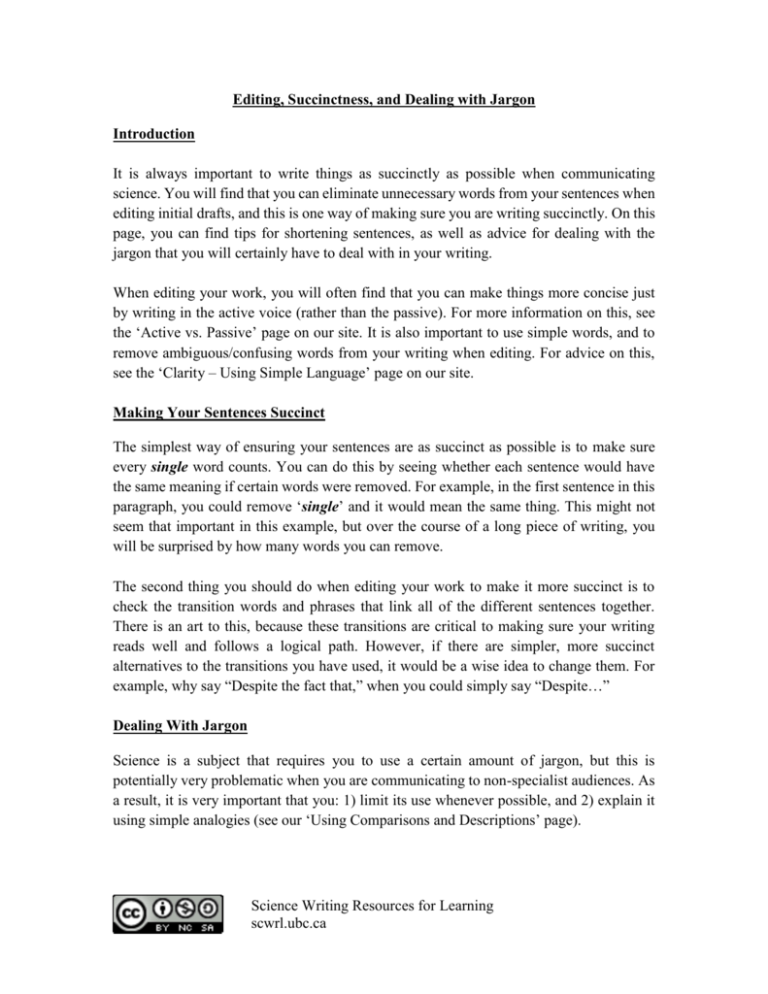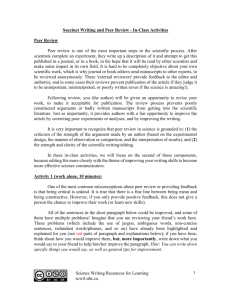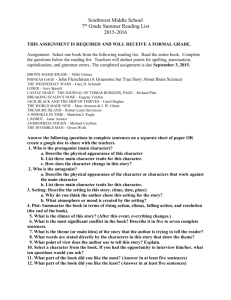Editing, Succinctness and Dealing with Jargon
advertisement

Editing, Succinctness, and Dealing with Jargon Introduction It is always important to write things as succinctly as possible when communicating science. You will find that you can eliminate unnecessary words from your sentences when editing initial drafts, and this is one way of making sure you are writing succinctly. On this page, you can find tips for shortening sentences, as well as advice for dealing with the jargon that you will certainly have to deal with in your writing. When editing your work, you will often find that you can make things more concise just by writing in the active voice (rather than the passive). For more information on this, see the ‘Active vs. Passive’ page on our site. It is also important to use simple words, and to remove ambiguous/confusing words from your writing when editing. For advice on this, see the ‘Clarity – Using Simple Language’ page on our site. Making Your Sentences Succinct The simplest way of ensuring your sentences are as succinct as possible is to make sure every single word counts. You can do this by seeing whether each sentence would have the same meaning if certain words were removed. For example, in the first sentence in this paragraph, you could remove ‘single’ and it would mean the same thing. This might not seem that important in this example, but over the course of a long piece of writing, you will be surprised by how many words you can remove. The second thing you should do when editing your work to make it more succinct is to check the transition words and phrases that link all of the different sentences together. There is an art to this, because these transitions are critical to making sure your writing reads well and follows a logical path. However, if there are simpler, more succinct alternatives to the transitions you have used, it would be a wise idea to change them. For example, why say “Despite the fact that,” when you could simply say “Despite…” Dealing With Jargon Science is a subject that requires you to use a certain amount of jargon, but this is potentially very problematic when you are communicating to non-specialist audiences. As a result, it is very important that you: 1) limit its use whenever possible, and 2) explain it using simple analogies (see our ‘Using Comparisons and Descriptions’ page). Science Writing Resources for Learning scwrl.ubc.ca Whenever possible, try not to have more than one jargon-heavy term in a single sentence, and use parentheses and abbreviations as a way of splitting up a passage of writing around these important but confusing terms. By placing the initial explanation of a term in parentheses, it forces your reader to pay special attention to it and it also sticks out from a body of text so that it is easy for your reader to skim back to it if they need to remind themselves of the explanation later on. Some Examples In the following examples, the second (B) version provides an example of dealing with jargon present in the first (A) version, before being edited for succinctness to give a final version (C). 1A: It is within the thermosphere that ionization occurs. 1B: The thermosphere is the layer of the Earth’s atmosphere that sits just below outer space. This is the part of the atmosphere in which individual atoms and molecules become charged (due to the loss or addition of electrons). 1C: Atoms and molecules become charged (due to losing or gaining electrons) in the thermosphere (the part of the Earth’s atmosphere that sits just below outer space). 2A: Our Linear Regression Model Fitter computer programme has proved to be very effective in highlighting patterns in bacterial populations. The Linear Regression Model Fitter computer programme was used by our researchers to show that antibiotic resistance can develop within 20 generations. 2B: Our Linear Regression Model Fitter computer programme (LRMF), which compares bacterial survival rate as drug dose changes, has proved to be very effective in highlighting patterns in bacterial populations. The LRMF was used by our researchers to show that antibiotic resistance can develop within 20 generations. 2C: Our Linear Regression Model Fitter computer programme (LRMF), which compares bacterial survival rate as drug dose changes, is effective in highlighting bacterial population patterns. The LRMF showed that antibiotic resistance can develop in 20 generations. -----------Video Resource For a recap and for some extra information about writing succinctly and dealing with jargon, please watch Grammar Squirrel’s video on the UBC Science Writing YouTube channel. Science Writing Resources for Learning scwrl.ubc.ca We then suggest you complete the quick quiz (below) to see whether you have mastered some of the important skills relating to succinct writing and dealing with jargon. ------------Editing, Succinctness and Dealing with Jargon Quick Quiz 1) Highlight the two unnecessary words in each of the following two sentences (4 marks): A) Many students worry about being accused of plagiarism because writing something totally unique is pretty difficult. B) In reality though, they do not need to worry, as long as they do not purposefully mean to copy someone else’s work. 2) The three following sentences begin with overly wordy transitions. Replace these with succinct alternatives without changing the meaning of the sentences (3 marks). A) In order to credit someone else’s work properly, you need to learn how to integrate citations in your writing. B) In view of this requirement, you should read our guide to help you learn how to do this effectively. C) At the present time, students tend to over-cite, rather than under-cite material that has shaped their writing. 3) The sentence below contains some confusing jargon. Split it into two sentences (1 mark), explain one piece of jargon (1 mark), and use parentheses for the other piece (1 mark) to make the sentence less confusing (3 marks total). The X-Ray Crystallography Callibrator is useful for determining the tertiary molecular structure of proteins, which provides us with crucial biological knowledge that can help us to design drugs that target specific proteins produced by bacteria. --------------Quick Quiz Answer Key To check your answers and see whether you are now a wizard at writing succinctly and dealing with jargon, access the answer key below. Science Writing Resources for Learning scwrl.ubc.ca 1) Highlight the two unnecessary words in each of the following two sentences (4 marks): A) Many students worry about being accused of plagiarism because writing something totally unique is pretty difficult. B) In reality though, they do not need to worry, as long as they do not purposefully mean to copy someone else’s work. 2) The three following sentences begin with overly wordy transitions. Replace these with succinct alternatives without changing the meaning of the sentences (3 marks). D) To credit someone else’s work properly, you need to learn how to integrate citations in your writing. E) Because of this requirement, you should read our guide to help you learn how to do this effectively. F) Currently, students tend to over-cite, rather than under-cite material that has shaped their writing. 3) The sentence below contains some confusing jargon. Split it into two sentences (1 mark), explain one piece of jargon (1 mark), and use parentheses for the other piece (1 mark) to make the sentence less confusing (3 marks total). The X-Ray Crystallography Callibrator (X-R CC) is useful for determining how different molecules fold and bond with one another to give each protein its unique shape. The X-R CC thus helps us to design drugs that target specific proteins produced by bacteria. Science Writing Resources for Learning scwrl.ubc.ca








